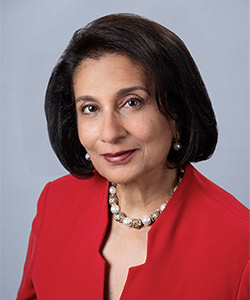By Dr. Rohini Anand

External diversity, equity and inclusion advisory boards (DEIAB) are not yet widely used: In Seramount’s 2020 Index, only nine percent of participating companies had an external DEIAB – up from eight percent in the 2019 index. However, the ones that exist are highly visible, in part because they often are composed of high-profile members and senior executives, including the CEO, from the organization. The boards are sometimes unveiled with great external media presence and referred to by various names such as Advisory Councils, Advisory Boards, Community Councils etc.
Having launched and managed a DEIAB, and currently serving on several others, I can vouch for the fact that they can provide tremendous value, but take a lot of work and a strong commitment. Unless they are well planned and managed, they may not benefit the organization as much as they could.
The purpose of DEIABs can be multifold and evolve over time to meet organizational needs. Organizations launch these boards to ensure that they stay focused and engaged on DEI, provide an external perspective and involve and apprise community stakeholders. Advisory boards are more common in the US than in other parts of the world, and are often used when organizations have faced litigation by employees, are under pressure from external stakeholders, or are in the public eye for not having an exemplary DEI track record.
While they are an effective way to engage external stakeholders and get expert input into an organization’s business and DEI strategy, external DEI advisory boards take time to manage and they take financial investment. As a result, the roles they play and their value to the organization needs to be carefully considered.
Let’s consider WHY an organization might have a DEIAB, WHAT roles they play and HOW best to operate them for maximum benefit to the organization.
WHY Have a DEI Advisory Board?
Well managed DEI advisory boards contribute in multiple ways and have tremendous value for the organization. They can:
- Provide insights on external trends and risks: DEI advisory boards provide counsel and benchmarking on navigating disruptions like COVID-19, Black Lives Matter and the pros and cons of remote work. They also provide advice on disruptive events like the US Supreme Court ruling on race-based admissions in higher education and the possible implications for DEI in the workplace.
- Identify opportunities for corporate leadership: DEI advisory boards provide an external perspective and help identify opportunities for leadership in the DEI space. They also provide input on when and where the organization might want to consider taking a stand on external issues like signing the Marriage Equality Amicus brief in the US or signing onto the International Labour Organization’s (ILO) charter – and any risks of doing so.
- Provide expertise and thought leadership: Members of the advisory boards may have expertise in specific subject areas and as such may be called upon to advise the organization on their area of expertise. For example, a board member with deep disabilities experience may advise the organization on accessibility or work with the relevant ERG.
- Foster learning: DEI advisory boards are often used to provide education and learning to the broader organization. The members’ lived experiences also serves to educate the organization’s executives.
- Benchmark: Advisory board members’ exposure and experience with a range of organizations can inform advisory board conversations. For example, in one organization whose DEI strategy was exclusively focused on talent, the advisory board was able to expand the organization’s range of vision beyond talent to DEI opportunities in marketing and the community.
- Signal commitment: The caliber of advisory board members – often prominent community members and thought leaders as well as the CEO and senior executives – publicly demonstrates the organization’s DEI commitment.
- Mitigate Risk: The existence of the advisory board and its membership signals the organization’s commitment to DEI and deflects risks such as attacks by civil rights organizations, labor unions or other activists.
- Represent their constituents: Advisory board members often represent their constituents and raise issues that might impact their stakeholders. On one advisory board, an LGBTQ advocate frequently pointed out that her community was left out of DEIAB conversations.
- Serve as a sounding board: Advisory board members are often used as a sounding board by organizational leaders to test ideas or to ask for advice or input. For example, in light of the US Supreme Court ruling on the use of race in higher education admissions, DEIAB members are being asked to provide input about the implications for the private sector.
- Hold the organization accountable: By asking challenging questions and requesting periodic updates against goals, the advisory board members hold the organization’s leaders accountable.
- Increase visibility: Advisory board members can communicate the organization’s commitment to DEI and significant accomplishments through their networks. This is a particularly effective way to broaden the sourcing for open positions.
- Serve as a true north during challenging times: During economic downturns when competing priorities can take precedence, advisory board members ensure that the organization remains focused on DEI.
WHAT Roles do DEI Advisory Boards Play?
DEIAB members play multiple roles that can evolve over time. Below are some roles they play.
DEI Thought Leaders for Strategy Advice:
External DEI Advisory boards can provide DEI thought leadership, serving as a sounding board on initiatives and strategies to improve diversity in the organization. Boston Fed, Toyota and Comcast have external boards that serve in this capacity. Based on their view of the external landscape, DEI advisory board members provide strategic input and guidance to senior leaders on supplier diversity, community engagement and the workforce. General Motors’ (GM) Inclusion Advisory Board has a goal of providing input on leveraging GM’s voice “to contribute to the dialogue condemning injustice and driving inclusion.” These external boards can be very effective in highlighting gaps in the organization before they become a crisis.
Targeted Insights on Consumer Trends:
Organizations also form advisory boards to offer insights on consumer purchasing habits. A good example is Neilson. Their External Advisory Councils are composed of business and community leaders representing the African American, Hispanic and Asian American communities and provide input on the viewing habits and purchasing power of these communities in the US. As they comprise trusted representatives from these communities, the councils also serve to build trust in the communities.
Building Credibility
In order to address the social unrest following the murder of George Floyd, organizations such as American Airlines launched their external council to provide insights on challenges encountered by Black travelers. This council was formed on the heels of a lawsuit by five passengers who alleged they were improperly removed from a flight because of racial discrimination by the airline. The council is composed of well-known Black leaders and is focused on helping American Airlines strengthen its relationship with Black customers by communicating with their stakeholders about the corrective actions American Airlines is taking. They play a critical role not only in sensitizing executives to issues they need to consider, but also contribute to improving the optics of the organization.
Holding Organizations Accountable:
Frequently DEI advisory boards are launched in response to pressure from external stakeholders, discrimination litigation by employees, or publicity for a poor DEI track record. The objective is to hold the company accountable to commitments they have made in response to litigation or external pressure. Such advisory boards are more common in the US. Take the example of T-Mobile or Charter Communications where the external council was created as part of its memorandum of understanding with civil rights organizations. Such advisory boards are typically composed of high-profile civil rights leaders representing various identity groups. Organizations like Sodexo launched a DEIAB after their discrimination litigation consent decree had expired in order to ensure that they continued to have external checks on their DEI progress.
Global DEI Advisory Boards for Overarching Coherence:
There are few examples of external DEI advisory boards globally. Two notable examples are Sanofi and L’Oréal. The objective is to provide external perspectives on key topics and identify potential blind spots as well as advise on external best practices and trends. Their global advisory boards are composed of global thought leaders and play a critical role in creating a learning space for internal stakeholders. L’Oréal has a global DEI advisory board and local advisory boards in the US, UK and Ireland.
HOW to best Operate a DEI Advisory Board for Maximum Benefit?
Setting up a DEIAB
- Be clear about the purpose
- Be intentional and strategic about member selection.
- Have clear criteria for selection of members based on the purpose
- Make sure they can make the time commitment, have passion for the topic, are well regarded and have organizational seniority
- Be clear about the ask – what do you want from Board members?
- Ensure a mix of senior internal business leaders and external members
- As you will be sharing highly confidential and proprietary information make sure the members sign a Non-Disclosure Agreement
Operations
- Ensure the CEO attends the meetings
- Spend time up front to build a cohesive group
- Have clear agendas with topical focus areas
- Include a business update by the CEO or senior business leader
- Be clear about meeting cadence (virtual and in person) and schedule at least one in person meeting a year
- Keep report outs from team members limited
- Provide pre-reads and time for discussion
- Agree on the time commitment and fee for the external members
- Consider term limits
- Assign committee work if appropriate
Getting the most from your DIAB
- Encourage members to share their lived experiences
- Share information about the business so the members understand the context
- Encourage the members to challenge without getting defensive
- Be transparent about the gaps and pain points and ask for support where needed.
- Allow opportunities for members to interact with employees to get a sense for the organizational culture
- Have the members amplify your messages to their networks
Conclusion
I have found that DEI Advisory Boards can provide amazing value to an organization’s executives and employees, to the business, as well as to the organization’s brand and image in the community. However, an organization needs to carefully consider launching such an advisory board based on the maturity of their DEI journey. At times DEI advisory boards can outlive their initial purpose and as such need to be disbanded or re-formulated to meet the evolving needs of the organization.
Given the benefit, I highly encourage more organizations to consider DEI advisory boards after considering their DEI maturity and the purpose of the advisory board. It takes courage and vulnerability on the part of the organization – but the benefits are manifold.

Dr. Rohini Anand
Dr. Rohini Anand is a pioneer of DEI, an author, and Senior Diversity, Equity and Inclusion Advisor, Rohini Anand LLC. She also serves as a senior fellow for The Conference Board, a global non-profit think tank. She previously served as Senior Vice President of Corporate Responsibility and Global Chief Diversity officer for Sodexo.






